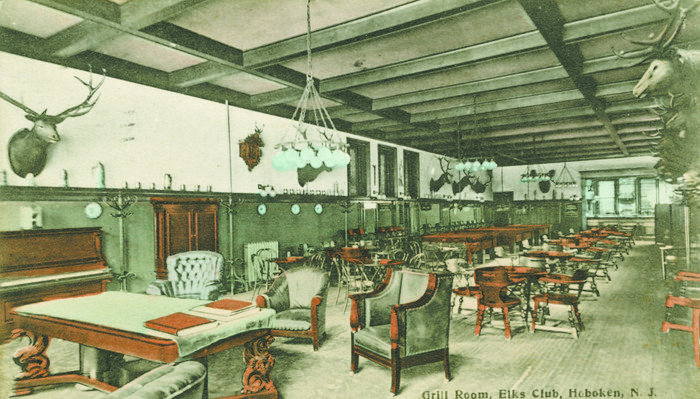From as early as the 1700s, Hoboken has been fertile ground for social clubs—from eating and drinking societies to civic, arts, and sports clubs.
Some groups built impressive club headquarters. The Brotherhood of the Paternal Order of Elks at 1005 Washington St. is still going strong. The Independent Order of Odd Fellows, which no longer has a local chapter, met at a building that stood at 412-414 Washington St., which until recently housed a Blockbuster video store at street level.
The Columbia Club at 11th and Bloomfield Streets, designed in the “Richardson Romanesque” style, was built in 1891 by some of the most prominent men in Hoboken. The club, which promoted cultural and civic improvement projects, featured spacious, mahogany-paneled rooms for billiards, receptions, and lectures, and bowling lanes in the basement.
Within 20 years the group had disbanded, and the building was taken over for a few decades by one of the many Masonic lodges in town. In the 1980s, the building was restored and converted into four condominiums that retain many of the original architectural details.
The clubhouse of the Hudson County Pigeon Club (HCPC), at 358 Newark St., still stands. Founded in 1922, the group built the current clubhouse after World War II. HCPC once had more than 70 members and sponsored the Hoboken Derby, one of the most famous pigeon races in North America. Members kept pigeon coops on rooftops, much like the one seen in On the Waterfront. The club is much smaller these days, as pigeon coops have largely been replaced with central air conditioning compressors. It now rents its facilities to The Pigeon Club recording studio.
Hoboken resident Vinnie Torre has shared his memories of the group’s glory days in an oral history chapbook, “The Pigeon Guys,” available at the Hoboken Historical Museum or downloadable on hobokenmuseum.org.
Other former clubhouses have been replaced by modern interpretations of the original. The Union Club at Sixth and Hudson Streets, built by the Deutscher Club in 1863-64, changed its name to the Union Club during World War I when German-Americans were closely monitored on suspicion of espionage. The club was later bought and run by the Samperi family, and converted to condos in the 1980s. The current building features a columned portico that echoes the original.
In Maxwell Place Park is a structure built to resemble one that was built at about that location in 1845—the New York Yacht Club. Hobokenite John Cox Stevens, son of Hoboken founder Col. John Stevens, was its first commodore. He and his brother, Edwin, helped design the legendary yacht America. In 1851, the brothers were members of the crew that sailed the America to Britain, capturing the coveted America’s Cup. The original NYYC clubhouse has been relocated twice and now sits on property owned by the group in Newport, RI.
One of Hoboken’s earliest recorded social groups dates to 1796, when scores of gourmands came from all over the region to feast on turtle soup and a smorgasbord of other delicacies. Turtle Club members’ drinking habits were so prodigious as to attract the attention of New York Times reporters.
To learn more about our town’s clubs, visit the Hoboken Historical Museum.—Melissa Abernathy, communications and volunteer coordinator, Hoboken Historical Museum.
Hoboken Historical Museum
1301 Hudson St.
(201) 656-2240
hobokenmuseum.org
“I Belong: A History of Hoboken Social Clubs”
July 29-December 23
The museum will be closed July 1-28.
